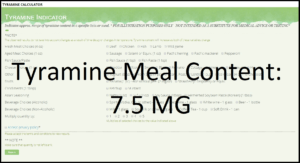
Suffering from migraines, we could have issues with the breakdown of the biogenic amine, tyramine. This may imply that our bodies are simply not producing enough of the enzymes needed to properly degrade or inactivate tyramine.
Why use a tyramine calculator
Implications for those of us with migraines
If the food that we consume causes the tyramine level to exceed beyond our specific threshold, then this could cause a number of health problems, including migraines.


Use the tyramine calculator to find out what some of the foods with significant tyramine content are
For migraine sufferers, it is virtually impossible to find specific tyramine information online. I am talking about information on the actual amount of tyramine that we might be getting from a meal. In terms of tyramine- containing foods , the lists that exist tend to provide us with foods to avoid and those that may be eaten with caution. But, they don’t really give us specific levels in a more organized fashion.
Furthermore, the level that will affect one person, may not affect another. We are, after all, different. I was curious to find what item or combination of items could be responsible for my migraines. I hoped to understand the amount of tyramine that my body might be absorbing based on a particular diet.
Quick desciption of Monoamine Oxidase A (MAO-A) & B (MAO-B)
These two enzyme types help inactivate tyramine inside our bodies. Therefore, if our bodies do not produce enough of the enzymes, tyramine might not get properly broken down. If tyramine continues to increase in our blood, it then triggers the release of something called “norepinephrine”, which can cause blood vessels to become constricted. As most of us have probably read, current research seems to indicate that it is this blood vessel constriction that is the cause behind our migraine pain. For more information on tyramine and the interaction with both MAO-A and MAO-B, I would encourage you to read this article on monoamine oxidase inhibitors.
The table below illustrates the ranges and effects when MAO-A is inhibited according to the Manual of Clinical Dietetics. Whether or not our own levels correspond to these ranges is difficult, if not impossible, to ascertain. However, to the extent that the MAO-A and/or MAO-B function is limited, then these ranges might be applicable.
